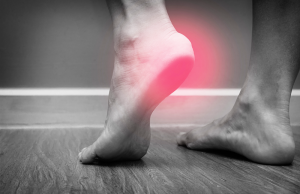By Eva Briggs
 Several years ago, while on an extended backpacking trip of the Appalachian Trail, I noticed pain in my right heel. It started slowly, and worked up to significant pain.
Several years ago, while on an extended backpacking trip of the Appalachian Trail, I noticed pain in my right heel. It started slowly, and worked up to significant pain.
Then I stumbled, slammed down hard on my foot, and the resulting serious jolt of pain told me this wasn’t merely a minor inconvenience that would resolve with over-the-counter pain relievers, taping and muscle rubs.
So I limped slowly 4.4 miles to the trailhead, where AT hostel operator and shuttle driver “Mechanical Man” gave me a ride back to civilization.
I drove home, saw an orthopedic doctor and learned that I had a stress fracture of my calcaneus (heel bone). So I thought that for this month’s article I’d write about common causes and treatments for heel pain. This is to raise awareness on the importance of knowing What Doctor to See for Heel Pain.
Calcaneal stress fractures arise from repetitive overuse of the heel. It could be an increase in weight bearing activities like running or hauling around a 25-pound backpack for hours, day after day. Or the overuse could entail walking on harder surfaces.
In any case, pain starts at first only with activity, and later happens at rest. Swelling and bruising are not always present. The fracture area is tender. Squeezing the heel often reproduces the pain.
Stress fractures don’t always show up on X-rays — mine didn’t. Sometimes a bone scan, CT or MRI reveals the fracture. The treatment is little to no weight bearing for up to six weeks, heel pads, and perhaps a walking boot. (My own personal favorite is the Tuli brand heel cup, which seems to last a long time and costs only about $10 per pair. They’re good for plantar fasciitis, too.)
Plantar fasciitis is the most common cause of heel pain. About one in 10 people battle this painful malady during their lifetime. The plantar fascia is a tough fibrous band that connects the heel to the toes. When inflamed, it causes a sharp stabbing pain near the heel. The pain is most severe first thing in the morning — or after resuming activity following a period of rest.
Once you have developed plantar fasciitis, getting rid of it is going to be a full time commitment. You will require very supportive footwear during your day. And if you enjoy walking around the house on slippers, then you are going to need slippers for plantar fasciitis with arch support .
People often blame plantar fasciitis on heel spurs, bony-like calcium deposits extending from the heel to the arch. Only 50 percent of people with heel spurs have pain, and patients with plantar fasciitis often have a normal X-ray with no heel spurs.
The diagnosis is based on history and exam, not on X-ray. Treatment is rest, activity modification, ice, anti-inflammatory medication and stretches. Other therapies include physical therapy, arch taping, foot orthotics and night splints. Instruction for heel taping with kinesiology tape (KT tape) is available online https://heelthatpain.com/plantar-fascia/plantar-fascia-taping/ When these measures aren’t sufficient, injections of steroids or plasma-rich platelets can jump-start the recovery process. Usually, a podiatrist will recommend you to get custom orthotics or arch support insoles to help decrease pain and discomfort when doing your daily activities.
Heel pain can also come from inflamed or injured nerves. Nerves in the foot and ankle can be trapped and pinched by overuse, trauma or previous surgery. Neuropathic pain often is burning and can be accompanied by tingling and numbness. A compressed nerve in the spine can also cause nerve pain, called radiculopathy, even without back pain. Tests that aid in the diagnosis include MRI and ultrasound to visualize the compressed nerve. Neuropathic heel pain is usually unilateral. Neuropathic pain in both heels might be due to an underlying systemic illness.
The Achilles tendon, which runs up the back of the heel (the heel cord), can become inflamed. That’s called Achilles tendinitis or tendinopathy. Usually it stems from mechanical overload such as excessive running. Sometimes the tendon is not only tender but has a swollen area. Treatments that help include activity change, exercises, pain relievers, heel lifts, and deep tendon massage. But steroid shots don’t help. They can even make the tendon rupture, which is bad thing with a prolonged recovery.
These are only a few of the most common causes of heel pain. So if your heel hurts, and doesn’t improve with the usual home treatments for aches and pains, get it checked out by a podiatrist. Your doctor can also use physical examination and X-rays to diagnose the presence of bunions. Don’t do what I did and wait until you can scarcely walk.
Eva Briggs is a medical doctor who works at two urgent care centers (Central Square and Fulton) operated by Oswego Health.

